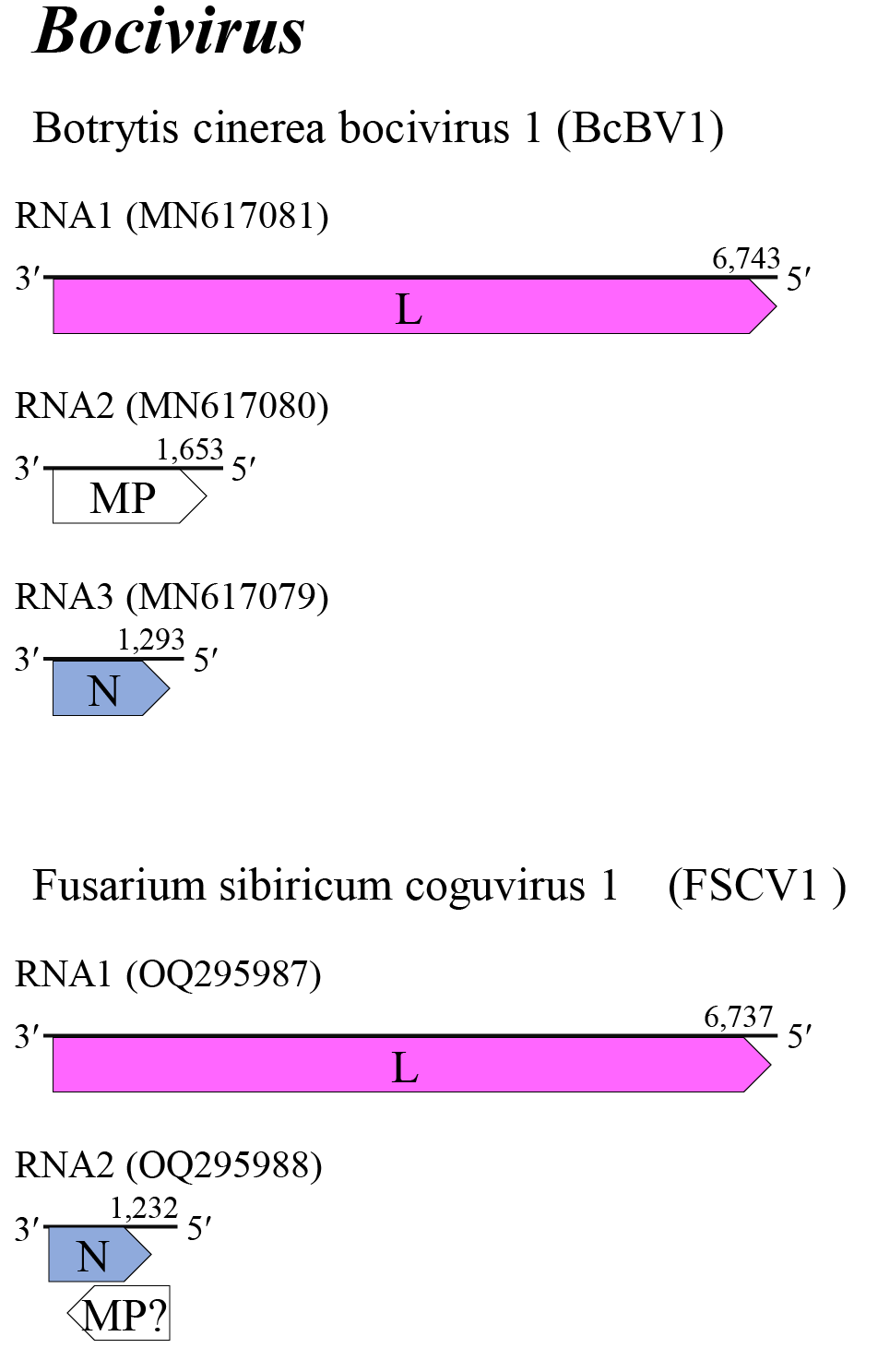Family: Phenuiviridae
Genus: Bocivirus
Distinguishing features
Four viruses assigned to the genus Bocivirus were discovered in plant-pathogenic fungi. Bociviruses have a genome consisting of three single-stranded segments of negative-sense RNA (RNA1, RNA2, and RNA3), or alternatively, a large negative-sense RNA (RNA1) and a small ambisense RNA (RNA2). These RNAs contain three genes, encoding two structural proteins, a large protein (L) and a nucleocapsid protein (N), and one putative non-structural protein likely encoding a movement protein (MP) to enable cell-to-cell movement in fungus hosts. The apparent lack of a membrane-bound virus particle distinguishes bociviruses from other viruses in the family Phenuiviridae. Based on well-supported Maximum Likelihood or Maximum Clade Credibility trees inferred from complete L protein sequences, viruses classified in the genus Bocivirus form a monophyletic cluster clearly distinguished from other phenuivirids (Chiapello et al., 2020, Ruiz-Padilla et al., 2012, Li et al., 2023, Pagnoni et al., 2023).
Virion
Morphology
Virion morphology is unknown. Based on the putative proteins encoded by the virus genome, the virion is probably a filamentous virion with a non-enveloped structure.
Nucleic acid and Protein
The bocivirus genome consists of either three RNA segments: RNA1 (6.7 kb), RNA2 (1.6–1.7 kb), and RNA3 (1.2–1.3 kb) or two RNA segments: RNA1 (6.7 kb) and RNA2 (1.2 kb). The terminal nucleotides of each segment occur in a canonical, conserved sequence (in coding sense) 5′-ACACAAAGAU… AACUAUGUGU-3′ and may form panhandle structures similar to those of other members of the class Bunyaviricetes (Table 2 Phenuiviridae). In silico analysis of coguvirus putative ORF sequences suggests that the bocivirus genome encodes two proteins with predicted molecular masses of 252–254 kDa and 38–39 kDa, homologous to the bunyaviral RNA-directed RNA polymerase (RdRP) domain and the tenuivirus/phlebovirus N domain, respectively. The genome may also encode third protein of 53 kDa that shares sequence homology and/or structural characteristics with the MP (Table 3 Phenuiviridae) (Chiapello et al., 2020, Ruiz-Padilla et al., 2012, Li et al., 2023, Pagnoni et al., 2023).
Genome organization and replication
Except for Fusarium sibiricum coguvirus 1 (FSCV1), bociviruses have three negative-sense RNA segments, all of which contain untranslated regions flanking a single ORF which is predicted to be expressed from the virus-complementary strand. (Figure 1 Bocivirus). RNA1 encodes the L protein that includes the RdRP domain. RNA2 and RNA3 encode MP and N, respectively. The genome of FSCV1 consists of two segments. RNA1 encodes the L protein. RNA2 exhibits an ambisense coding strategy and encodes N and a putative MP from overlapping genes. Since most mycoviruses encode viral suppression proteins that counteract fungus antiviral defence mechanisms based on RNA silencing, one or more of these three proteins encoded by bociviruses may possibly interfere with RNA silencing. Details of virus replication are unknown (Chiapello et al., 2020, Ruiz-Padilla et al., 2012, Rodriguez Coy et al., 2022, Li et al., 2023, Pagnoni et al., 2023).
 |
| Figure 1 Bocivirus. Genome organization of some bociviruses. Coloured boxes depict ORFs that encode N, nucleocapsid protein and L, large protein. White boxes depict ORFs that encode MP, non-structural cell-to-cell movement protein. |
Biology
Bociviruses were detected by high-throughput sequencing of RNAs from the plant-pathogenic fungi [Botrytis cinerea (Pers., 1801), Fusarium sibiricum (Gagkaeva, Burkin, Kononenko, Gavrilova, O'Donnell, T. Aoki, & Yli-Mattila, 2016), Trichoderma gamsii (Samuels & Druzhinina, 2006), and Plasmopara viticola (Berl. & De Toni, 1888) (Chiapello et al., 2020, Ruiz-Padilla et al., 2012, Li et al., 2023, Pagnoni et al., 2023).
Species demarcation criteria
The criteria demarcating species in the genus are:
• Less than 95% identity in the amino acid sequence of RdRP.
Related, unclassified viruses
| Virus name | Accession number | Virus abbreviation |
| Sanya phenuivirus 1 | RNA1: MZ209936; RNA2: MZ209937; RNA3: MZ209938 | SaPV1 |
Virus names and virus abbreviations are not official ICTV designations.

